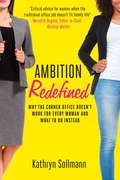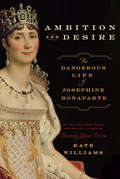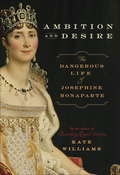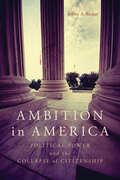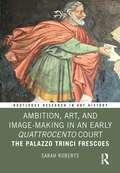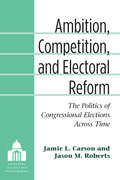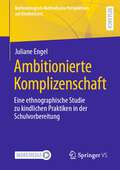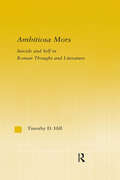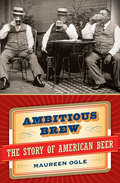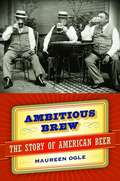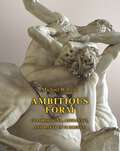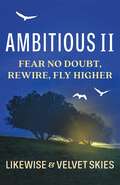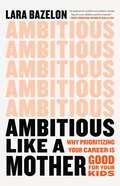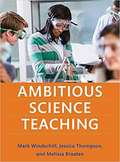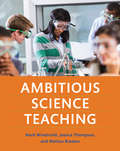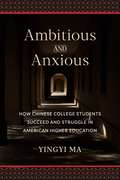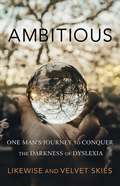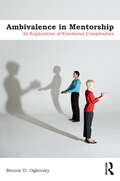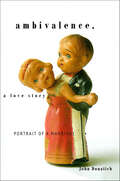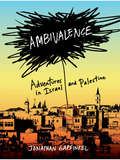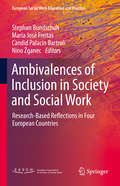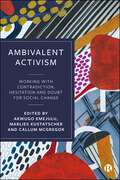- Table View
- List View
Ambition Redefined: Why the Corner Office Doesn't Work for Every Woman & What to Do Instead
by Kathryn Sollmann"CRITICAL ADVICE FOR WOMEN WHEN THE TRADITIONAL OFFICE JOB DOESN'T FIT FAMILY LIFE." "Sollmann advocates that we 'lean in' to what she aptly labels one's own personal measure of success, rather than a monolithic vision of the ideal career."-- Whitney Johnson, critically-acclaimed author, Build an A Team and Disrupt Yourself, Thinkers50 Management Thinkers Ambition Redefined is a timely alternative to current women's business books that define professional ambition and success as climbing the corporate ladder. In fact, this is not a path that all women want or should feel pressured to follow. Sollmann's focus is on the more critical and widespread workplace issue for everyday women--to always work in a way that fits their lives alongside their two major caregiving roles: for children and aging parents. Sollmann debunks common assumptions such as:IT'S NOT "WORTH IT" UNLESS THE SALARY IS HIGH. Women forfeit up to 4X their salaries every year out of the workforce to care for children and/or elderly parents--and it does not take a six-figure salary to achieve long-term financial security. FINDING FLEXIBLE WORK IS IMPOSSIBLE. Sollmann shines a bright light on the ever-widening world of flexwork--where women can find many interesting and exciting ways to tuck all generations of their families into a future that is financially secure and safe. The book includes realistic, practical tools for preparing for and finding flexible work within a current job or a new opportunity.IT WON'T HAPPEN TO ME. Divorce, death of a spouse, or unexpected financial support for aging parents are some of the life "you never knows" that all women could experience. Divorce, death of a spouse, caring for aging parents or adult children are some of the life "you never knows" that all women could experience. Sollmann encourages women to anticipate and buffer life surprises and she shows the profound impact of continual earning, saving, and investing toward a long and comfortable retirement. WORK ENDS AT AGE 65. Women who leave the workforce and want to return in their forties, fifties or sixties will be in good company as the ranks of older workers rise. Over the next two decades, adults age 50 and over will have greater rates of workforce participation into their sixth and seventh decades.Eye-opening and practical, the book shows that when we redefine ambition, we acknowledge that challenging, lucrative work can be found in many flexible ways that favor personal satisfaction over public applause.
Ambition and Desire
by Kate WilliamsFrom CNN's official royal historian, a highly praised young author with a doctorate from Oxford University, comes the extraordinary rags-to-riches story of the woman who conquered Napoleon's heart--and with it, an empire. Their love was legendary, their ambition flagrant and unashamed. Napoleon Bonaparte and his wife, Josephine, came to power during one of the most turbulent periods in the history of France. The story of the Corsican soldier's incredible rise has been well documented. Now, in this spellbinding, luminous account, Kate Williams draws back the curtain on the woman who beguiled him: her humble origins, her exorbitant appetites, and the tragic turn of events that led to her undoing. Born Marie-Josèphe-Rose de Tascher de La Pagerie on the Caribbean island of Martinique, the woman Napoleon would later call Josephine was the ultimate survivor. She endured a loveless marriage to a French aristocrat--executed during the Reign of Terror--then barely escaped the guillotine blade herself. Her near-death experience only fueled Josephine's ambition and heightened her determination to find a man who could finance and sustain her. Though no classic beauty, she quickly developed a reputation as one of the most desirable women on the continent. In 1795, she met Napoleon. The attraction was mutual, immediate, and intense. Theirs was an often-tumultuous union, roiled by their pursuit of other lovers but intensely focused on power and success. Josephine was Napoleon's perfect consort and the object of national fascination. Together they conquered Europe. Their extravagance was unprecedented, even by the standards of Versailles. But she could not produce an heir. Sexual obsession brought them together, but cold biological truth tore them apart. Gripping in its immediacy, captivating in its detail, Ambition and Desire is a true tale of desire, heartbreak, and revolutionary turmoil, engagingly written by one of England's most praised young historians. Kate Williams's searing portrait of this alluring and complex woman will finally elevate Josephine Bonaparte to the historical prominence she deserves.
Ambition and Desire
by Kate WilliamsFrom CNN's official royal historian, a highly praised young author with a doctorate from Oxford University, comes the extraordinary rags-to-riches story of the woman who conquered Napoleon's heart--and with it, an empire.Their love was legendary, their ambition flagrant and unashamed. Napoleon Bonaparte and his wife, Josephine, came to power during one of the most turbulent periods in the history of France. The story of the Corsican soldier's incredible rise has been well documented. Now, in this spellbinding, luminous account, Kate Williams draws back the curtain on the woman who beguiled him: her humble origins, her exorbitant appetites, and the tragic turn of events that led to her undoing.Born Marie-Josèphe-Rose de Tascher de La Pagerie on the Caribbean island of Martinique, the woman Napoleon would later call Josephine was the ultimate survivor. She endured a loveless marriage to a French aristocrat--executed during the Reign of Terror--then barely escaped the guillotine blade herself. Her near-death experience only fueled Josephine's ambition and heightened her determination to find a man who could finance and sustain her. Though no classic beauty, she quickly developed a reputation as one of the most desirable women on the continent.In 1795, she met Napoleon. The attraction was mutual, immediate, and intense. Theirs was an often-tumultuous union, roiled by their pursuit of other lovers but intensely focused on power and success. Josephine was Napoleon's perfect consort and the object of national fascination. Together they conquered Europe. Their extravagance was unprecedented, even by the standards of Versailles. But she could not produce an heir. Sexual obsession brought them together, but cold biological truth tore them apart.Gripping in its immediacy, captivating in its detail, Ambition and Desire is a true tale of desire, heartbreak, and revolutionary turmoil, engagingly written by one of England's most praised young historians. Kate Williams's searing portrait of this alluring and complex woman will finally elevate Josephine Bonaparte to the historical prominence she deserves.
Ambition in America: Political Power and the Collapse of Citizenship
by Jeffrey A. BeckerMost Americans admire the determination and drive of artists, athletes, and CEOs, but they seem to despise similar ambition in their elected officials. The structure of political representation and the separation of powers detailed in the United States Co
Ambition, A History: From Vice to Virtue
by William Casey KingIs &“ambitious&” a compliment? It depends: &“[A] masterpiece of intellectual and cultural history.&”—David Brion Davis, author of Inhuman Bondage: The Rise and Fall of Slavery in the New World From rags to riches, log house to White House, enslaved to liberator, ghetto to CEO, ambition fuels the American Dream. Yet at the time of the nation's founding, ambition was viewed as a dangerous vice, everything from &“a canker on the soul&” to the impetus for original sin. This engaging book explores ambition&’s surprising transformation, tracing attitudes from classical antiquity to early modern Europe to the New World and America&’s founding. From this broad historical perspective, William Casey King deepens our understanding of the American mythos and offers a striking reinterpretation of the introduction to the Declaration of Independence. Through an innovative array of sources and authors—Aquinas, Dante, Machiavelli, the Geneva Bible, Marlowe, Shakespeare, Thomas Jefferson, and many others—King demonstrates that a transformed view of ambition became possible the moment Europe realized that Columbus had discovered not a new route but a new world. In addition the author argues that reconstituting ambition as a virtue was a necessary precondition of the American republic. The book suggests that even in the twenty-first century, ambition has never fully lost its ties to vice and continues to exhibit a dual nature—positive or negative depending upon the ends, the means, and the individual involved.
Ambition, Art, and Image-Making in an Early Quattrocento Court: The Palazzo Trinci Frescoes (Routledge Research in Art History)
by Sarah RobertsThis study provides new interpretations of the little-known but fascinating Palazzo Trinci frescoes, relating them for the first time both to their physical context and to their social, political, and cultural environment.Chapters show how a humanist agenda subverted the historical and mythical associations more frequently used to promote powerful families, to point the Trinci family in new directions. It also shows how the artists involved adapted established civic, religious, and chivalric imagery in support of these ideas. The book argues that the resulting decorations are highly unusual for the period, in their serious political and social purpose. Positioning the Trinci as bringers of peace, not war, the family is now associated with culture and education and presented as willing to encourage debate about the character of the virtuous ruler and the nature of good government.The book will be of interest to scholars working in art history and Renaissance studies.
Ambition, Competition, and Electoral Reform: The Politics of Congressional Elections Across Time
by Jamie L. Carson Jason Matthew RobertsIn Ambition, Competition, and Electoral Reform, Jamie L. Carson and Jason M. Roberts present an original study of U.S. congressional elections and electoral institutions for 1872-1944 from a contemporary political science perspective. Using data on late nineteenth and early twentieth century congressional elections, the authors test the applicability in a historical context of modern political science theories, assess the effects of institutional reforms, and identify the factors that shape the competitiveness of elections. They present several key findings: the strategic politicians theory is applicable in an era without candidate-centered campaigns; there was an incumbency advantage prior to the full development of candidate-centered campaigns; institutional reforms have had a significant effect on elections; and the degree of electoral competition frequently correlates with elected officials' responsiveness to citizens.
Ambition: Why It's Good to Want More and How to Get It
by Rachel BridgeBe bold. Be brave. Embrace your ambition. Ever have that nagging feeling that you are better than the sum of your current achievements? Do you have a secret desire to be achieving much more, to change the world or to reach the top of your game? Then it is time to use your ambition to your advantage. It has been proven that ambitious people achieve greater levels of success, whether that be a higher level of education, a more prestigious job, a higher income or more satisfaction in life. Grounded in scientific research and with contributions from people at the height of their success in business, music, the arts and sport, Ambition will help you to harness your aspirations to achieve your lifetime goals. It will give you practical insights into how to use your talents and learn from others who have done it before, so that you can get to where you want to be. If you want to get that promotion, achieve that big life-changing goal, start your own successful business, receive that distinctive acclaim, or make a positive difference to the world, then the good news is that you already have the fuel of ambition in you. This book will show you how to use it to drive your success. Reveals how you can do more than you think with what you've already got Helps discover your true motivation using a psychology model and shows you how to use that as the fuel for greater success Contains insights from successful people in all fields including John Torode, Myleene Klass, Will Greenwood, Katie Hopkins and Gavin Patterson Shows that the world is an exciting place and you can do anything if you use your ambition to help you
Ambitionierte Komplizenschaft: Eine ethnographische Studie zu kindlichen Praktiken in der Schulvorbereitung (Methodologisch-Methodische Perspektiven auf Kindheit(en))
by Juliane EngelIn der ethnographischen Studie wird der Frage nachgegangen, wie Kinder am Angebot der institutionellen Schulvorbereitung teilnehmen bzw. wie sie dieses (mit-)hervorbringen. Hierfür wurden die Kinder über ihr letztes Kindergartenjahr hinweg während dieses Arrangements begleitet und teilnehmend beobachtet. Neben den aktuellen Konzepten der Kindheitsforschung spielen hierzu praxistheoretische Zugänge eine zentrale Rolle und deren relationale Perspektive auf Schulvorbereitung, als soziales Gefüge aus Akteur:innen, Artefakten und den zugrundeliegenden Strukturen. Die Ergebnisse zeigen, wie sich Kinder innerhalb der Schulvorbereitung zu Kompliz:innen der Fachkräfte und deren pädagogischen Schulvorbereitungsprogramme entwickeln. Mit der „Ambitionierten Komplizenschaft“ stellt die Arbeit darüber hinaus eine konzeptionelle Weiterentwicklung vor, indem sie das besondere Engagement der beobachteten Kinder während der Schulvorbereitung betont.
Ambitiosa Mors: Suicide and the Self in Roman Thought and Literature (Studies in Classics)
by T. D. HillFirst Published in 2004. Routledge is an imprint of Taylor & Francis, an informa company.
Ambitious Brew
by Maureen OgleAmbitious Brew, the first-ever history of American beer, tells an epic story of American ingenuity and the beverage that became a national standard. Not always America’s drink of choice, beer finally took its top spot in the nation’s glasses when a wave of German immigrants arrived in the mid-nineteenth century and settled in to re-create the beloved biergartens they had left behind. Fifty years later, the American-style lager beer they invented was the nation’s most popular beverage-and brewing was the nation’s fifth-largest industry, ruled over by titans Frederick Pabst and Adolphus Busch. Anti-German sentiments aroused by World War I fed the flames of the temperance movement and brought on Prohibition. After its repeal, brewers replaced flavor with innovations such as flashy marketing and lite beer, setting the stage for the generation of microbrewers whose ambitions would reshape the brew once again. Grab a glass and a stool as Maureen Ogle pours out the surprising story behind your favorite pint.
Ambitious Brew: The Story of American Beer
by Maureen OgleFrom the Book Jacket: In this first-ever history of American beer, Maureen Ogle tells its epic story, from the German immigrants who invented it to the upstart microbrewers who revived it. Beer might seem as American as baseball, but that has not always been true: Rum and whiskey were the drinks of choice in the 1830s, with only a few breweries making heavy, yeasty English ale. When a wave of Germans arrived in the middle of the nineteenth century, they promptly set about re-creating the pleasures of the biergartens they had left behind. Just fifty years later, the American-style lager beer that they invented was the nation's most popular beverage-and brewing was the nation's fifth-largest industry, ruled by fabulously wealthy titans Frederick Pabst and Adolphus Busch. But anti-German sentiments aroused by World War I inflamed an already aggressive anti-drink campaign (one activist even declared that "the worst of all our German enemies are Pabst, Schlitz, Blatz, and Miller"), and Prohibition ended brewing's first golden age. In the wake of its repeal, brewers replaced flavor with innovations like marketing and lite beer, setting the stage for a generation of microbrewers whose ambitions reshaped the drink. With panoramic scope and sweep, Maureen Ogle creates a portrait of the innovators and entrepreneurs behind our familiar brews and restores an essential piece of our American story. MAUREEN OGLE is a historian and the author of two previous books, All the Modern Conveniences and Key West. She lives in Ames, Iowa, a town of fifty thousand whose only stand-alone liquor store stocks nearly six hundred different beers.
Ambitious Form: Giambologna, Ammanati, and Danti in Florence
by Michael W. ColeAmbitious Form describes the transformation of Italian sculpture during the neglected half century between the death of Michelangelo and the rise of Bernini. The book follows the Florentine careers of three major sculptors--Giambologna, Bartolomeo Ammanati, and Vincenzo Danti--as they negotiated the politics of the Medici court and eyed one another's work, setting new aims for their art in the process. Only through a comparative look at Giambologna and his contemporaries, it argues, can we understand them individually--or understand the period in which they worked. Michael Cole shows how the concerns of central Italian artists changed during the last decades of the Cinquecento. Whereas their predecessors had focused on specific objects and on the particularities of materials, late sixteenth-century sculptors turned their attention to models and design. The iconic figure gave way to the pose, individualized characters to abstractions. Above all, the multiplicity of master crafts that had once divided sculptors into those who fashioned gold or bronze or stone yielded to a more unifying aspiration, as nearly every ambitious sculptor, whatever his training, strove to become an architect.
Ambitious II: Fear No Doubt, Rewire, Fly Higher
by LikewiseAMBITIOUS II is a motivating, eye-opening venture to explore the inhibiting areas of fear, anxiety, and doubt. You will relate right away. Written from Likewise's vantage point and interspersed with his pivotal episodes, his knowledge, groundbreaking methods, and sincere eagerness to assist the readers shine brilliantly throughout the pages. This timely book is choc-full of original concepts, terms, and tips. Find out how to transform from a "negative noggin" to a "positive processor." Discover your personality type: are you "smooth-wired," "lightning-wired," or a "smooth-lightning wired" dynamo? Ultimately, you will learn how to successfully rewire and fly higher!
Ambitious Like a Mother: Why Prioritizing Your Career Is Good for Your Kids
by Lara BazelonIn this captivating and radical look at &“work-life balance,&” Lara Bazelon reframes our understanding of working women—and shows how prioritizing your career benefits mothers, kids, and society at large.In this singular cultural moment, mothers have unparalleled opportunities to succeed at work while continuing to face the same societal impediments that held back our mothers and grandmothers. We still encounter entrenched gender bias in the workplace and are expected to shoulder the lion&’s share of labor and burdens at home while being made to feel as if we&’re never doing enough. All the while we&’re told that the perfect work-life balance is possible, if only we try hard enough to achieve it.It&’s time to change the conversation—about work, life, and &“balance.&” Work and life are inextricably, intimately intertwined. We need to celebrate what we do give our children—even and especially in moments of imbalance—rather than apologizing for what we don&’t. In this way, we can model for our children how we use our talents to help others and raise awareness about the issues closest to our hearts. We can embrace the personal fulfillment and financial independence that pursuing meaningful work can bring as a way of showing our children how to live happy, purpose-driven lives. Bazelon argues not only that we can but that we should. Being ambitious at work and being a good mother to our children are not at odds—these qualities mutually reinforce each other.Backed up by research and filled with personal stories from Bazelon&’s life, as well as that of her mother and the many other women she interviewed across the cultural and financial spectrum, Ambitious Like a Mother is an anthem, a beacon for all to recognize and celebrate the pioneering women who reject the false idols of the Selfless Mother and Work-Life Balance, and a call to embrace your own ambitions and model your multiplicities for your children.
Ambitious Science Teaching
by Jessica Thompson Mark Windschitl Melissa BraatenAmbitious Science Teaching outlines a powerful framework for science teaching to ensure that instruction is rigorous and equitable for students from all backgrounds. The practices presented in the book are being used in schools and districts that seek to improve science teaching at scale, and a wide range of science subjects and grade levels are represented. The book is organized around four sets of core teaching practices: planning for engagement with big ideas; eliciting student thinking; supporting changes in students’ thinking; and drawing together evidence-based explanations. Discussion of each practice includes tools and routines that teachers can use to support students’ participation, transcripts of actual student-teacher dialogue and descriptions of teachers’ thinking as it unfolds, and examples of student work. The book also provides explicit guidance for “opportunity to learn” strategies that can help scaffold the participation of diverse students. Since the success of these practices depends so heavily on discourse among students, Ambitious Science Teaching includes chapters on productive classroom talk. Science-specific skills such as modeling and scientific argument are also covered. Drawing on the emerging research on core teaching practices and their extensive work with preservice and in-service teachers, Ambitious Science Teaching presents a coherent and aligned set of resources for educators striving to meet the considerable challenges that have been set for them.
Ambitious Science Teaching
by Jessica Thompson Mark Windschitl Melissa Braaten2018 Outstanding Academic Title, ChoiceAmbitious Science Teaching outlines a powerful framework for science teaching to ensure that instruction is rigorous and equitable for students from all backgrounds. The practices presented in the book are being used in schools and districts that seek to improve science teaching at scale, and a wide range of science subjects and grade levels are represented. The book is organized around four sets of core teaching practices: planning for engagement with big ideas; eliciting student thinking; supporting changes in students&’ thinking; and drawing together evidence-based explanations. Discussion of each practice includes tools and routines that teachers can use to support students&’ participation, transcripts of actual student-teacher dialogue and descriptions of teachers&’ thinking as it unfolds, and examples of student work. The book also provides explicit guidance for &“opportunity to learn&” strategies that can help scaffold the participation of diverse students. Since the success of these practices depends so heavily on discourse among students, Ambitious Science Teaching includes chapters on productive classroom talk. Science-specific skills such as modeling and scientific argument are also covered. Drawing on the emerging research on core teaching practices and their extensive work with preservice and in-service teachers, Ambitious Science Teaching presents a coherent and aligned set of resources for educators striving to meet the considerable challenges that have been set for them.
Ambitious and Anxious: How Chinese College Students Succeed and Struggle in American Higher Education
by Yingyi MaOver the past decade, a wave of Chinese international undergraduate students—mostly self-funded—has swept across American higher education. From 2005 to 2015, undergraduate enrollment from China rose from under 10,000 to over 135,000. This privileged yet diverse group of young people from a changing China must navigate the complications and confusions of their formative years while bridging the two most powerful countries in the world. How do these students come to study in the United States? What does this experience mean to them? What does American higher education need to know and do in order to continue attracting these students and to provide sufficient support for them? <P><P>In Ambitious and Anxious, the sociologist Yingyi Ma offers a multifaceted analysis of this new wave of Chinese students based on research in both Chinese high schools and American higher-education institutions. Ma argues that these students’ experiences embody the duality of ambition and anxiety that arises from transformative social changes in China. These students and their families have the ambition to navigate two very different educational systems and societies. Yet the intricacy and pressure of these systems generate a great deal of anxiety, from applying to colleges before arriving, to studying and socializing on campus, and to looking ahead upon graduation. Ambitious and Anxious also considers policy implications for American colleges and universities, including recruitment, student experiences, faculty support, and career services.
Ambitious: One Man's Journey to Conquer the Darkness of Dyslexia
by LikewiseAmbitious is an autobiography that chronicles the life of a remarkable man who overcame his learning disabilities and other major difficulties to become a highly respected and successful adult.This book is an autobiography that chronicles the life of a remarkable man who overcame his learning disabilities and other major difficulties to become a highly respected and successful adult. For many, only one of these issues he faced would have been enough of a reason to give up. Not so with Likewise who always found creative solutions in order to grow and succeed. It was his desire to share these experiences with others in hopes that he could help them realize their potential no matter what challenges they face.
Ambivalence in Mentorship: An Exploration of Emotional Complexities
by Bonnie D OglenskyAmbivalence in Mentorship is based on research of scores of mentors and protégés in longstanding relationships representing a range of career fields. Using vivid case narratives, the book takes a nuanced look at the emotional complexities of their mentorships—the intense passions and hopes that get stirred up in these professional, yet intimate connections as well as the turmoil created by disappointment, betrayal, competition, and the mere readiness to move on and separate from these relationships.Framing the psychodynamics of mentorship dialectically, the book unpacks the relational struggles in mentorship to trace how these emerge from strong emotional bonds. This is accomplished by delineating and illustrating three modes of the ambivalent attachment between mentor and protégé: idealization, loyalty, and generativity. Pushing at the boundaries of research on the topic, Ambivalence in Mentorship locates this relationship at the crosshairs of authority and love—highlighting the interplay of intrapsychic, interpersonal, cultural, and historical forces that drive this relationship to be at once vital and risky. Professionals in the social sciences, business, and management fields will find that the book offers a fresh perspective and authentic voice to the very real joys and complicated feelings that attend mentorship.
Ambivalence, a Love Story: Portrait of a Marriage
by John DonatichAmbivalence, a Love Story is a deeply nuanced accounting in which two people come together to make a marriage work. Rarely has marriage and its compromises been so intimately portrayed, especially when tested by depression, unemployment, miscarriage and other realities of contemporary life. Whether inside the sterile out-placement offices for reengineered executives or traipsing through the suburban homes and competing lifestyles with perky realtors, Donatich muses on life's transitions with rare candor and insight. Ambivalence traces the inner life of a man coming into adulthood: on being first generation, on interfaith marriage, on playing the accordion and ultimately on the question of whether we are better off solitary or coupled. But at heart, it is a tender -- if circumspect -- love story. An astonishing middle-aged debut.
Ambivalence: Adventures in Israel and Palestine
by Jonathan GarfinkelWith lofty ideals, spectacular ambivalence, and endearing naiveté, Jonathan Garfinkel explores Israel and Palestine by talking to ordinary people. Jonathan Garfinkel can't make up his mind--not about his girlfriend, or Judaism, or Israel. After hearing about a house in Jerusalem where Jews and Arabs coexist in peace, he decides it's time to venture there. In Israel, nothing is as he imagined it, and nothing is as he was taught. Garfinkel gives us the people behind the headlines: from secret assignations with Palestinian activists and an uninvited visit at an Arab refugee camp to Passover with Orthodox Jewish friends and finding the truth about the mythic coexistence house, Ambivalence is the provocative, surreal, and often hilarious chronicle of his travels. In this part memoir and part quest, Garfinkel struggles with the growing divisions in a troubled region and with the divide in his soul. "Marvelous. Garfinkel deftly mines what it means to simultaneously belong, disavow, love, and loathe an identity, a culture, and a history.... A must-read."--David Rakoff
Ambivalences of Creating Life: Societal and Philosophical Dimensions of Synthetic Biology (Ethics of Science and Technology Assessment #45)
by Margret Engelhard Kristin Hagen Georg Toepfer"Synthetic biology" is the label of a new technoscientific field with many different facets and agendas. One common aim is to "create life", primarily by using engineering principles to design and modify biological systems for human use. In a wider context, the topic has become one of the big cases in the legitimization processes associated with the political agenda to solve global problems with the aid of (bio-)technological innovation. Conceptual-level and meta-level analyses are needed: we should sort out conceptual ambiguities to agree on what we talk about, and we need to spell out agendas to see the disagreements clearly. The book is based on the interdisciplinary summer school "Analyzing the societal dimensions of synthetic biology", which took place in Berlin in September 2014. The contributions address controversial discussions around the philosophical examination, public perception, moral evaluation and governance of synthetic biology.
Ambivalences of Inclusion in Society and Social Work: Research-Based Reflections in Four European Countries (European Social Work Education and Practice)
by Stephan Bundschuh Maria José Freitas Càndid Palacín Bartrolí Nino ŽganecThis book represents the work of the European Research Network: Inclusive Society and the Role of Social Work, which comprises researchers from Barcelona, Spain; Koblenz, Germany; Maastricht, The Netherlands; and Zagreb, Croatia. The authors present research results and reflections from these four different European countries to provide a comprehensive introduction and discussion of the ambivalences of inclusive processes in society and social work. The development towards an inclusive society is a subject of ongoing discussion in Europe. How the subject is addressed, through an examination of political and social characteristics, differs significantly by country. Each country-specific chapter includes evidence-based reflections on inclusive society and the role of social work: In The Netherlands, there is evidence of a top-down process implementing inclusive social policy and social work principles through the self-proclaimed ‘participation society’. In Spain, the process to inclusion is accompanied by the third sector often replacing governmental responsibilities, namely through the bottom-up activities of non-governmental organizations in social work. In Croatia, inclusion is a state initiative in transitioning society and an academic approach to deinstitutionalising social work. In Germany, inclusion is discussed in social systems theory and the reform of school systems. In the migration discourse it was introduced as a less-loaded alternative to integration. Ambivalences of Inclusion in Society and Social Work: Research-Based Reflections in Four European Countries is a useful resource for learners, teachers, practitioners, and researchers in social work, as well as those who have an interest in social policy, social welfare, and sociology.
Ambivalent Activism: Working with Contradiction, Hesitation and Doubt for Social Change
by Akwugo Emejulu, Marlies Kustatscher and Callum McGregorWhat if doubt, hesitation and ambivalence weren’t barriers to activism but powerful tools for change? Challenging the idea that activism is fuelled only by anger or hope, this bold collection explores how activists across anti-racism, climate justice and mental health navigate uncertainty to sustain their work. Blending scholarship with on-the-ground perspectives, this book highlights ambivalence not as a weakness but as a dynamic force. This is essential reading for anyone engaged in activism or emotional research, redefining what it means to feel and act for justice in a complex world.
